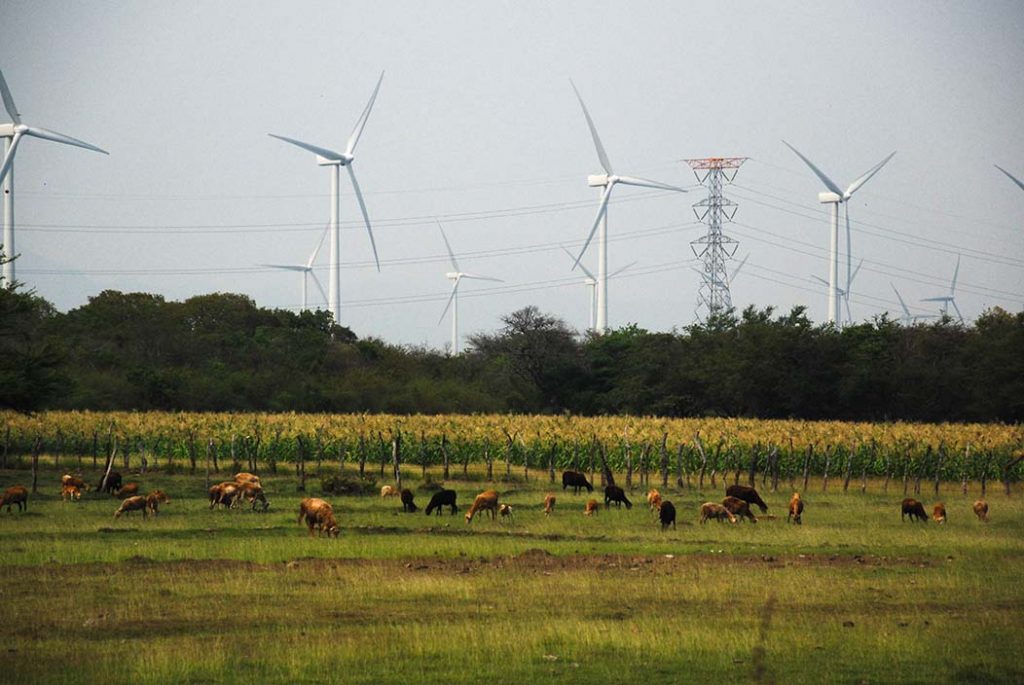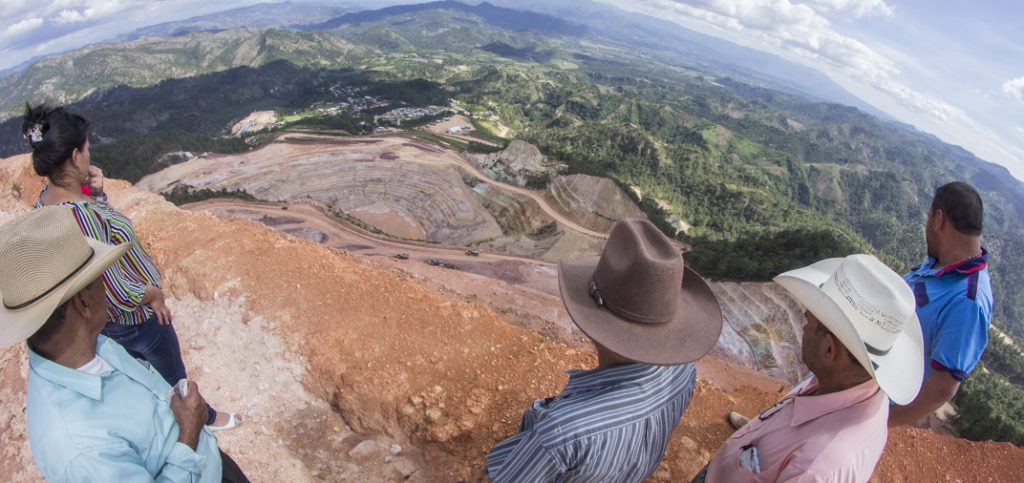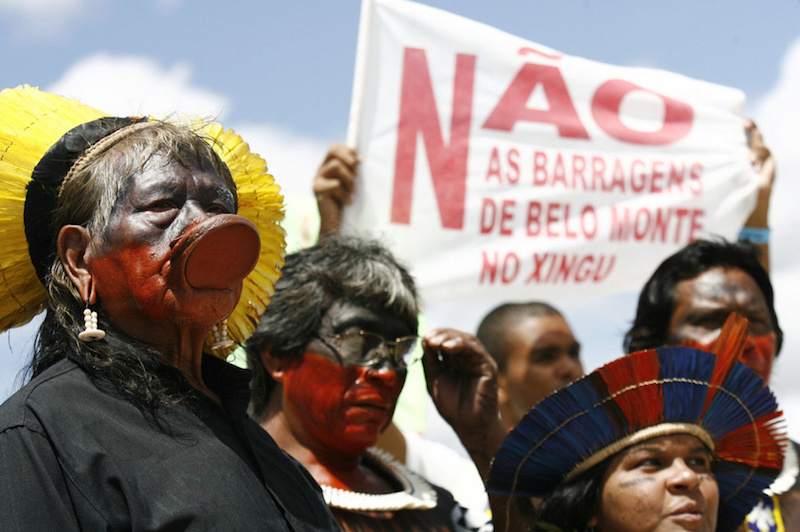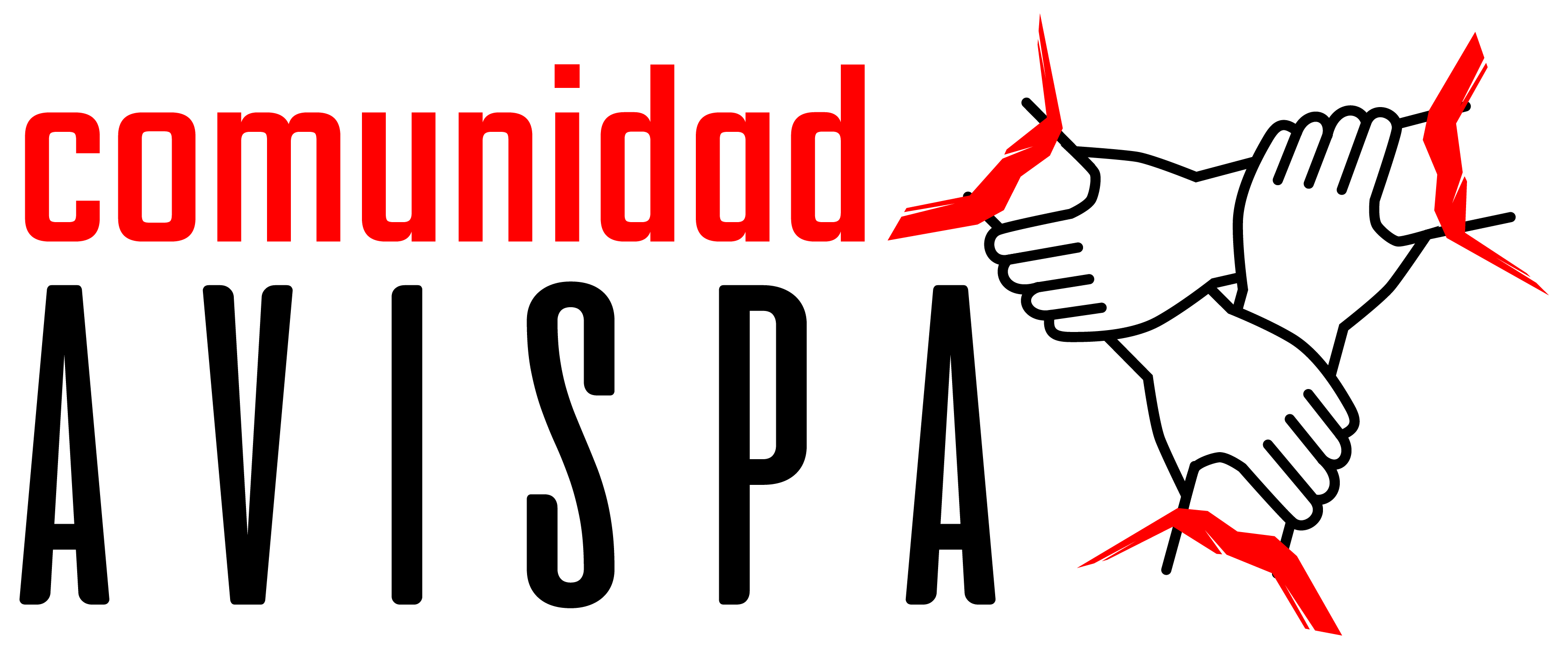On the cover: Explosions at the San Xavier mine, owned by New Gold, on San Pedro Hill, San Luis Potosí, Mexico. The Canadian company, which began mining in 2007, calls its work "environmentally responsible mining," despite the fact that its operations displaced most of the surrounding inhabitants. Photo: Aldo Santiago.
Governments across the planet have implemented energy transitions as urgent economic policies to deal with climate change. Although territories and the international division of labor are being reconfigured in several ways globally, the old frameworks of dispossession and theft continue to be reproduced in Latin America.
High temperatures have taken people by storm across the planet. Others have had to deal with catastrophic flooding. Losses range from real estate, to crops, to hundreds of deaths, to entire forests devastated by fire or water. While some have felt this hell firsthand, others remain comfortably distant. The idea that has been sold about climate change or global warming is that the market solves everything, with new production chains of goods and services that are part of what is now known as "sustainable development."
For environmental organizations, governments, academic circles, and the business world, the problem is the old fossil fuel energy system, and so-called “renewable energies” are the solution. In other words, a new assembly line is being laid out in the name of “climate change,” claiming to change everything, so that everything in fact remains the same. As Samir Amin explains, capitalist accumulation—even if it calls itself sustainable—is synonymous with "exponential growth," which, "like cancer, carries death" (Amin, 2009).
These supply chains debut their new “eco-friendly” look, promising to be the solution to climate change while failing to name or question the true reality: a “climatic, systemic, and civilizational crisis,” in Amin’s words, that heaps risks onto those who are already most vulnerable.
Our current society, disciplined for sustainable markets, makes justifications for a "green neoliberalism" that has been privatizing and commodifying common goods such as wind, solar energy, river water, ocean waves, lava from volcanoes—the list goes on.
The discourse on these not-so-new solutions takes different forms across the globe. This reconfiguration of markets and territories is not the same in Europe as it is in Africa or Latin America. Paraphrasing André Gunder Frank, we first need to understand how the rich countries reached their phase of “development” and the countries of the South remained in an eternal “underdevelopment” (Gunder Frank, 2005), which has led supranational financial institutions to describe them romantically as “developing or emerging countries.”
It’s important to understand this historical context in order to track where reconfigurations of green capitalism are already starting to lead, especially when the replacement of the energy matrix is repeating the same dynamics.
Renewable energies not only resort to the old international division of labor—in which some lose and others win and the South produces exclusively for the waste of the global North—but at the same time, they redouble environmental racism towards the South. In our case, this means Latin America, and more specifically Native peoples, Black communities, artisans, and autonomous communities.
Energy for the North
The United States, with only 4% of the world's population—a little over 332 million inhabitants—consumes more than 25% of global energy production. Its oil consumption exceeds 18 million barrels per day.
In 2000, the California ISO—a non-profit public benefit corporation that manages 80% of California’s energy flow—began issuing temporary “flex alerts” at times when electricity demand would outpace supply. The alerts urge businesses, government, and consumers to voluntarily reduce their electricity usage.
The California legislature passed a renewable energy mandate in 2011 stipulating that by 2020, 33% of electricity sold by California utility companies must come from renewable sources. To achieve this goal, however, California would need 10,000 of megawatts of additional capacity, according to a 2009 USAID report.
The report mentions Mexico as a potential source of this additional power, especially Oaxaca, with a production capacity of 2,600 MW—an “opportunity” for Mexican wind energy, in the USAID’s words. However, at the time, the high voltage networks necessary to sell electricity to the US did not yet exist.
Years before the Mexican government, led at the time by President Enrique Peña Nieto, began its Special Program for Energy Transition, the United States had already suggested that Mexico implement an energy reform. The US government argued that, despite sharing more than 3,000 km of border, electricity trade between Mexico and the United States was relatively limited and the advantages of proximity should be utilized.
The Peña Nieto government launched its energy reform in 2013, together with the 2014-2018 National Infrastructure Program, claiming that the main obstacles in the electricity sector were the saturation of transmission lines and the need for “high voltage networks” to connect to areas where renewable electricity is generated.
These transmission lines from Oaxaca have advanced slowly and have not yet met the goal of bringing energy to the US. However, they have been connected to major automobile assembly plants owned by General Motors, Ford, Chrysler, and others. Maquiladoras and shopping centers in Mexico, owned by US and European capital, have also benefited. In addition, the first interconnection networks in Baja California were established with the Western Electric Coordination Council (WECC) in California through two private interconnections. The state-owned Federal Electricity Commission (CFE) also has seven interconnections with Texas in the northern part of its system. In exchange, Mexico imports shale gas from the US.
The Isthmus of Tehuantepec region continues to spearhead wind energy production, with 28 of the 31 wind farms in operation throughout Mexico. According to the General Panorama of Renewable Energies, these generate a combined total of 7.7 GW.

According to data from the CFE, Mexico produced 48,958 GWh of “clean energy” in 2021. Of this, 67.2% came from hydroelectric sources, followed by nuclear power with 23.7%. Geothermal, wind, and photovoltaic power combined made up 9.1%.
Mexico has positioned itself as the second largest producer of solar energy in Latin America, just behind Brazil, with an installed photovoltaic capacity of more than 7 GW in 2021.
Interconnection networks are advancing rapidly in southern and southeastern Mexico, where the Andrés Manuel López Obrador (AMLO) administration has focused its stategic work through the Program for the Expansion and Modernization of the National Transmission Network and General Distribution Networks of the Wholesale Electricity Market.
The AMLO government recently established agreements with 17 US companies to increase the production of solar and wind energy. In turn, United States Secretary of EnergyJennifer Granholm stated on Twitter that "Mexico’s sun and renewable resources could power Mexico’s needs 100 times over — not to mention creating whole new clean energy industries."
According to the US Department of Energy, Mexico has enough capacity to produce 24,918 GW in solar energy alone. The Department also states that wind energy production can be increased to 3,669 GW, conventional geothermal energy by 2.5 GW, and hydroelectric energy by 1.2 GW. This would mean installing thousands of solar panels, more wind farms, and other renewable energy generation complexes that would affect hundreds of communities—the same ones that have to pay high costs for energy access.
Meanwhile, interconnection networks are also being built in Central America, claiming to "contribute to the sustainable development of the region" through the Central American Electricity Market Framework Treaty. Central American Electrical Interconnection System (SIEPAC) member countries have named integration of renewable energies as one of their objectives. These networks connect with Mexico to the north and extend to Colombia in the south.
SIEPAC will make it possible for privately held renewable energy plants to connect to each other through a network financed by governments in the region. Their goal is to insert renewable energy into the regional market, destined for maquiladoras, assembly plants, and extractive industries such as “green mining.”
The Development of Underdevelopment Continues
The Energy Policy Research Foundation, Inc. (EPRINC), a non-profit research organization focused on energy economics and policy, recently warned that the energy matrix replacement strategy promoted by the International Energy Agency (IEA) was not working as planned. This transition means “halting new investment in oil and gas exploration” based on “a false belief that the world will not require additional supplies of oil and gas in the medium term.” This, along with COVID-19 and the war between Russia and Ukraine, has led to an increase in "energy prices and energy poverty," wrote EPRINC spokesman Iván R. Sandrea Silva in a May 2022 report.
Sandrea unintentionally dealt a heavy blow to the argument supporting the economic policies promoted by the UN 2030 Agenda, which aims at a considerable reduction in carbon emissions by 2030 through the replacement of fossil fuels with renewables. He maintained that "even in the best-case scenario of reaching net zero [emissions], over 1.5 trillion barrels of oil and gas will be needed until 2070.”
Sandrea stated that African and Latin American countries should not "[shut] down the hydrocarbon industry," noting that they depend on it for their "economic growth and fiscal stability."

While the countries of the global North rapidly replace their energy sources, Latin American countries will serve as a bridge towards that transition. Not only will we continue to supply fossil fuel energy; we will also have to cede more land to produce green energy and expand mining areas, since we will have to supply aluminum, copper, lead, lithium, manganese, nickel, silver, steel, zinc, and other rare earth minerals for new production chains.
The World Bank estimates that more than three billion tons of minerals and metals will be needed to implement new technologies for wind, solar, and geothermal energy as well as for electric cars.
A fierce dispute has begun within the capitalist class itself to control and manage the exploitation and commercialization of these minerals. During the Security in the Western Hemisphere 2022 Concordia Americas Summit held in July 2022, General Laura Richardson, Commander of the US Southern Command, expressed her concern about the presence of Russia and China in Latin America, stating, “I think they’re there to undermine America, they’re there to undermine democracies.” Richardson reminded attendees that “the ‘lithium triangle’ is in this region. There are many things that this region has to offer.”
Months prior, in a panel talk at the Reagan National Defense Forum held in December 2021, Richardson stated: “60% of the lithium in the world is in the Lithium Triangle; Argentina, Bolivia, Chile. You've got a lot of rare earth minerals, resources and capabilities that in my mind go hand in hand with what the Chinese are doing with the Belt and Road Initiative and expanding their reach into Latin America.”
Lithium is just one of the minerals essential to the new markets, especially for batteries for the electric cars that rich countries think will solve the problem of climate change. This new commodity is an example of how the reconfiguration of green capitalism reproduces the old international division of labor and, at each stage of production, destructive consequences that classical economics calls "market failures" or "negative externalities."

While in poor countries electric vehicles are still seen as a thing of the distant future, a record 6.6 million of them sold in 2021 alone in the world’s most powerful economies. More than 16.5 million electric cars are already out on these countries’ roads and this is only the beginning.
The old fleet of internal combustion vehicles will not be destroyed, merely displaced to poor countries such as Mexico and Central America, as has always been done historically with obsolete technology. In the end, the solution presented by the individual car does not solve the problem, but it does represent a new niche of opportunities that take the form of greater "sustainable economic growth." On the other hand, it will continue to reproduce an individualistic, selfish, and competitive society—larger vehicles, including those used for collective transport, only represented 0.3% of global sales in 2021.
According to the IEA, the emergence of this green industry is due to the fact that in 2021, subsidies and incentives for electric vehicles in countries with the greatest economic power added up to 30 billion dollars. The increase in sales of electric vehicles was led by the People's Republic of China, with 3.3 million. 2.3 million were sold in Europe and 630,000 in the US.
“[Electric vehicle] sales are still lagging in other emerging and developing economies, where the few models that are available remain unaffordable for mass-market consumers,” states the IEA report. However, Latin America and the Caribbean make up one of the regions where renewable energy production has accelerated, mainly hydroelectricity. According to a 2019 report by the Inter-American Development Bank, hydroelectric power "provides about half of the electricity of this region and is the main source of generation in many countries," including Paraguay, Colombia, Costa Rica, Ecuador, and Brazil.
With that fact in mind, the cost that users have to pay is far higher than it should be in countries like Haiti, Guatemala, and Honduras, where according to USAID, more than 70% of the population is energy poor. In addition to lacking energy access, they are dispossessed and expelled from their territories. This is the face of the "sustainable development" promoted by governments, academia, and above all, business. The discourse of sustainability is a smoke screen ensuring a new cycle of expansion of capital and this represents an escalation of dispossession. Meanwhile, many sectors of society have been meekly accepting the false solutions that green capitalism is offering.
A Green Economy Stained Blood Red
The Belo Monte project in Brazil, Barro Blanco in Panama, Chixoy in Guatemala, and the San Antonio Hydroelectric Project in Mexico have something in common besides being large-scale hydroelectric projects: murders of Indigenous people have stemmed from all of them. These are just a few examples of the bloodstained projects that have imprisoned and persecuted people and displaced or dispossessed entire communities. The Sustainable Development Goals, bank reports, governments, and businesses do not talk about it.

Although it does not name the murders, even the controversial USAID reported in its Trend Analysis 2020-2030 that in 2017 alone, hydroelectric dams impacted 5.7 million people in South America. In addition, dams built to generate “renewable energy” also generate deforestation and negative impacts on a great diversity of species.
If we also consider the environmentalists killed by the other electrical plants and "development" projects in general, we are talking about hundreds of communities affected in the name of "climate change" and the energy transition. There is a reason that for years, the organization Global Witness has consistently ranked Latin America as the deadliest region for environmental defenders. Although renewable energy in the region—mainly privately owned and linked to European and US companies—represents more than double the world average in terms of its percentage on the grid, the results are less than stellar, since “energy poverty still undermines livelihoods in many areas,” according to USAID. We can infer that this energy transition is not about solving the climate crisis and much less about improved access for consumers. It is strictly the continuation of the expanded reproduction of capital.
This new market niche is under dispute by the most powerful countries and companies in the world, including those in the oil sector. So, asking them to include us in their agendas, reforms, or strategic plans is like getting blood from a stone. The underlying logic is still exponential growth.
Instead, we must envision and build alternatives outside this "renewed," greenwashed system. Repurposing technology and producing our own energy, independently of companies and state administration, becomes subversive. We must name the crisis and rethink alternatives from below, outside of what the concepts of "development" and "growth" have led us to believe. The solutions will either be subversive or, with so-called "sustainable development," we will head complacently towards the solutions offered by the green market and remain a disciplined army of consumption. The energy transition does not seek to solve the climate crisis, only to sustain the pace of capital accumulation at any cost.


